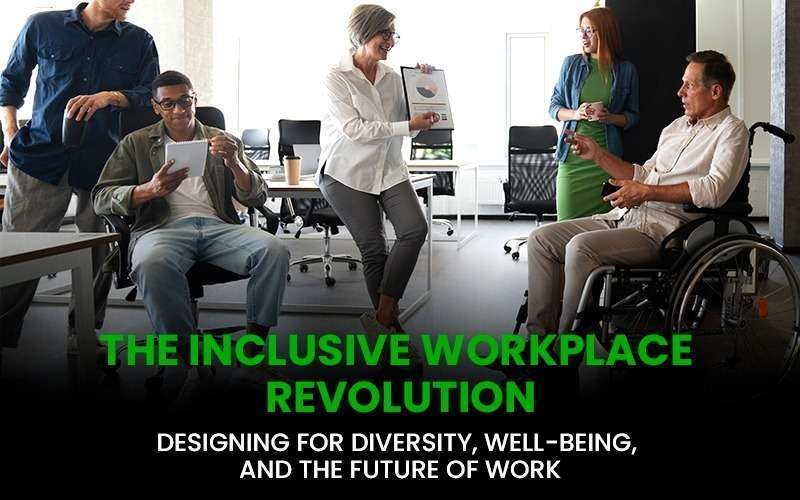
The Inclusive Workplace Revolution: Designing for Diversity, Well-being, and the Future of Work
Inclusive workplace, which cater to diverse needs and offer spaces like quiet zones and biophilic elements, are proven to attract top talent, boost productivity, and drive innovation.
As the majority of employees prefer hybrid work in 2024, office design is shifting to prioritise flexibility, inclusivity, and well-being.
By embracing these trends, companies can create environments that empower employees and foster a sense of belonging, ultimately leading to greater success.
What is an Inclusive Workplace
Inclusive workplaces, as the name suggests, are designed to embrace everyone.
These are spaces where employees feel valued, supported, and empowered to do their best work.
Inclusive design goes beyond mere functionality, prioritising physical and emotional well-being to create an environment where productivity is optimised.
Key Pillars
Flexibility and sustainability are key pillars of inclusive design.
Flexible layouts with diverse work zones cater to various preferences and needs, while sustainable practices create a healthier, more eco-conscious workspace.
By focusing on these core principles, companies can build offices that not only attract and retain top talent but also foster a culture of innovation and collaboration.
In an inclusive workplace, employees feel comfortable being themselves, regardless of their abilities, backgrounds, or working styles.
This leads to a more engaged, productive, and ultimately, successful workforce.
Key Characteristics: Creating a Space for Everyone
Inclusive office design is all about creating a workplace where every employee feels welcomed, comfortable, and empowered to do their best work.
Here’s how it translates into tangible features:
1. Physical Accessibility
Imagine a workplace where an employee using a wheelchair can effortlessly navigate wide corridors, enter meeting rooms with ease, and adjust their workstation to the perfect height.
This is physical accessibility in action, removing barriers and ensuring that everyone can move freely and independently.
2. Sensory Considerations
Picture an office where the lighting is soft and adjustable, acoustic panels absorb excess noise, and the air is fresh and free of harsh scents.
This thoughtful approach to sensory design minimises distractions, reduces stress, and creates a calming environment that benefits everyone, especially those with sensory sensitivities.
3. Flexible Workspaces
Envision a workplace with a variety of spaces to choose from – cosy nooks for focused work, vibrant collaborative zones for brainstorming, and comfortable lounges for informal chats.
This flexibility empowers employees to choose the environment that best suits their work style and task at hand, boosting productivity and satisfaction.
4. Technology Integration
Imagine a workplace where assistive technologies like screen readers and voice recognition software are readily available, where adjustable workstations can be controlled with a smartphone app, and where video conferencing connects remote and in-office teams seamlessly.
5. Universal Design Principles
Consider an office with clear, intuitive signage that guides everyone effortlessly, lever door handles that are easy to operate, and furniture designed for comfort and adaptability.
These universal design principles benefit all employees, creating a more user-friendly and welcoming workspace.
Why Inclusive Office Design is a Strategic Advantage for Your Business
Beyond merely checking regulatory boxes, inclusive office design is a powerful tool that directly impacts your company’s bottom line, employee satisfaction, and overall success.
Here’s how:
A Talent Magnet in a Competitive Market
In today’s fierce competition for skilled professionals, a welcoming, inclusive workspace is a key differentiator.
It signals to potential employees that you value diversity and create an environment where everyone can thrive, regardless of their background or abilities.
This not only broadens your talent pool but also attracts individuals who bring fresh perspectives, innovative ideas, and a drive to succeed – a place where new aspirants would love to join.
Enhanced Productivity and Unleashed Innovation
When employees feel physically comfortable, mentally supported, and emotionally valued, their engagement and performance naturally soar.
Inclusive design factors like ergonomic furniture, quiet zones, and natural lighting reduce distractions and stress, fostering a focused and creative atmosphere where ideas flow freely.
This translates to higher productivity, increased innovation, and ultimately, a stronger competitive edge.
Stronger Brand Reputation and Wider Appeal
Consumers and stakeholders increasingly expect companies to demonstrate social responsibility.
An inclusive workplace showcases your commitment to diversity, equity, and inclusion (DEI), boosting your brand image and attracting socially conscious clients and partners.
A reputation for inclusivity can also positively influence customer loyalty and brand perception.
Reduced Absenteeism and Burnout
Inclusive design takes a holistic approach to employee well-being, considering both physical and mental health.
Ergonomic furniture and a variety of workspaces can help prevent physical discomfort and injuries, while features like quiet zones and wellness areas address mental health concerns.
A comfortable and supportive environment reduces stress and burnout, leading to lower absenteeism, higher retention rates, and a healthier, happier workforce.
Improved Communication and Conflict Resolution
Inclusive design can foster a more open and collaborative atmosphere, where employees feel comfortable communicating their needs and concerns.
This open communication promotes trust, understanding, and respect among team members, leading to improved conflict resolution and a more positive, harmonious work environment.
Increased Profitability and Innovation
Numerous studies have consistently shown a strong correlation between diversity and inclusion and financial performance.
Inclusive workplaces are more innovative, adaptable, and better equipped to understand and meet the needs of a diverse customer base.
This ultimately drives greater profitability and sustainable growth.
Overcoming Barriers to Inclusive Workplace
Despite the benefits, some businesses hesitate to implement inclusive design due to perceived costs or lack of awareness.
However, integrating these principles early in the design process can actually save money in the long run by avoiding costly outdated designs.
Financial Concerns & Traditional Workplace Insufficiencies
Financial Concerns: While traditional designs may seem cheaper upfront, inclusive design’s long-term benefits outweigh initial costs, offering ROI through increased productivity and employee retention.
Lack of Awareness: Traditional workplace norms often overlook diverse needs. Education and training on inclusive design can highlight its value for all employees, fostering a welcoming environment.
Resistance to Change: Traditional layouts can be rigid and unaccommodating. Showcasing successful inclusive workplaces inspires a shift in mindset and demonstrates the positive impact on company culture.
Limited Expertise: Traditional design approaches often lack specialized knowledge. Collaborating with experts in inclusive environments ensures a comprehensive and effective strategy.
Short-Term Thinking: Traditional designs prioritise immediate costs, neglecting long-term gains. Inclusive design focuses on employee well-being and reduced turnover, leading to sustainable cost reduction over time.
Unconscious Bias: Traditional norms may inadvertently perpetuate biases. Inclusive design, with diversity training and employee involvement, actively minimises bias and promotes equity.
Lack of Employee Input: Traditional offices often exclude employee voices in design decisions. Inclusive design gathers diverse perspectives through surveys and focus groups, ensuring the space truly serves everyone.
Communication: Traditional workplaces may lack transparency in design choices. Inclusive design prioritises communication throughout the process, ensuring everyone understands the value and goals.
Regular Evaluation: Traditional offices often lack feedback mechanisms. Inclusive design uses regular evaluation and feedback to identify areas for improvement and maintain effectiveness.
Core Value: Traditional workplaces may lack a focus on inclusivity. Embracing inclusive design as a core value fosters a culture of belonging and equity, leading to a more welcoming and thriving workplace.
Inclusive Solutions
Traditional office spaces often fall short in meeting the diverse needs of today’s workforce.
Coworking spaces offer a simple yet powerful solution to overcome these limitations.
These flexible environments prioritise inclusivity with diverse work settings that cater to various needs and preferences.
They also champion sustainability through eco-friendly practices and offer additional amenities like virtual offices, meeting rooms, and event spaces.
This holistic approach fosters productivity, creativity, and well-being, making coworking a compelling alternative for businesses seeking inclusive and efficient workspaces.
In a nutshell
By prioritising inclusive office design, you’re not just creating a more welcoming space; you’re investing in your company’s future.
It’s a strategic decision that benefits employees, your brand, and your bottom line. In 2024 and beyond, inclusive design is not just a trend; it’s a business imperative for staying competitive and attracting the best talent.
Build Your Inclusive Workplace at GreenNest
Struggling with traditional office limitations? GreenNest Kochi offers a flexible, inclusive, and sustainable coworking solution.
Our diverse workspaces cater to individual needs, while eco-friendly practices and amenities like virtual offices and meeting rooms enhance productivity and well-being.
Join our vibrant community and experience the future of work. Contact us today!



